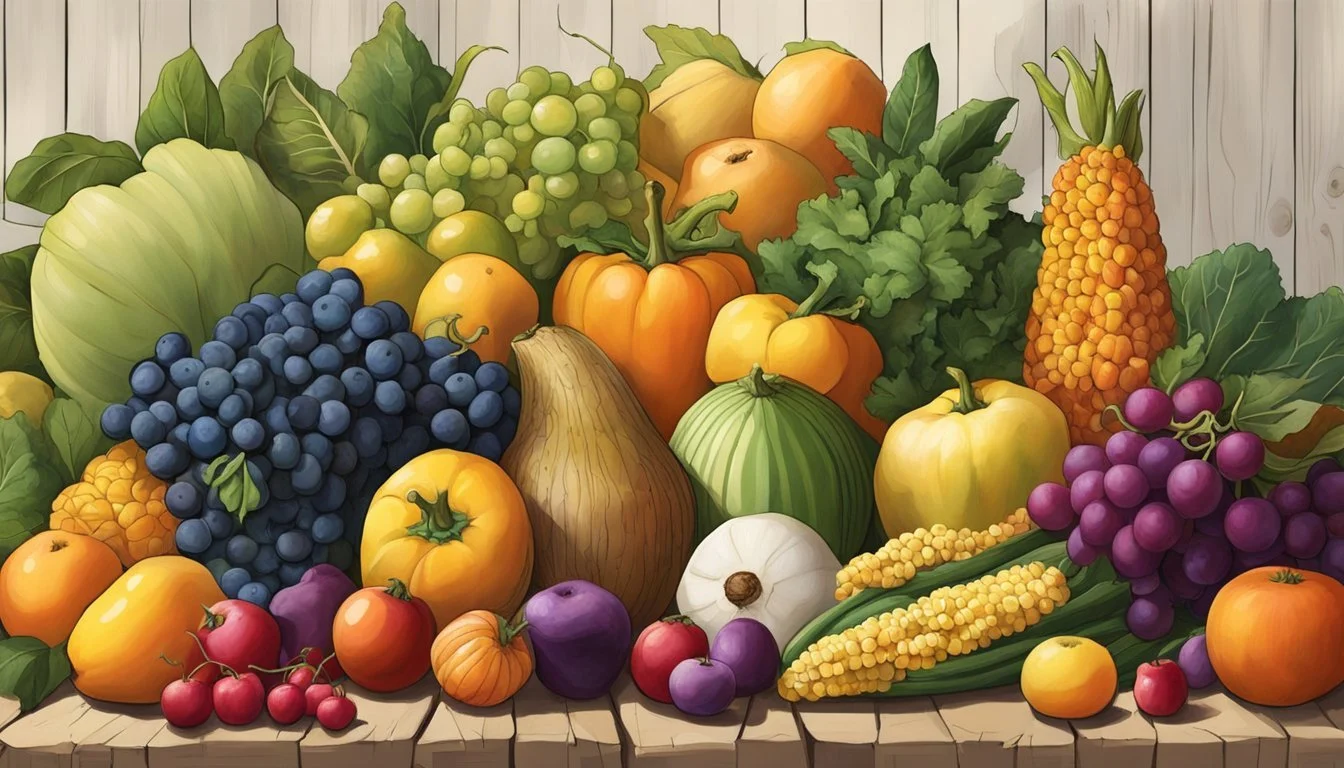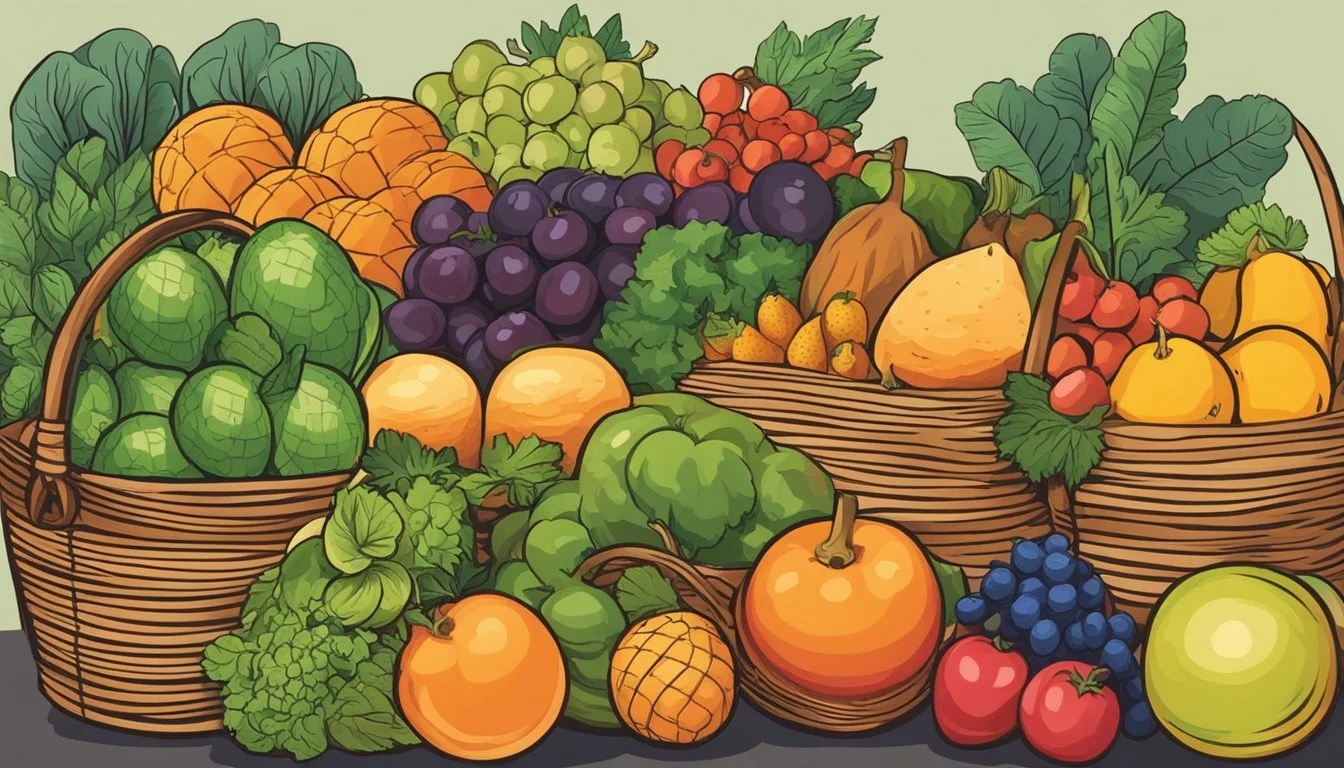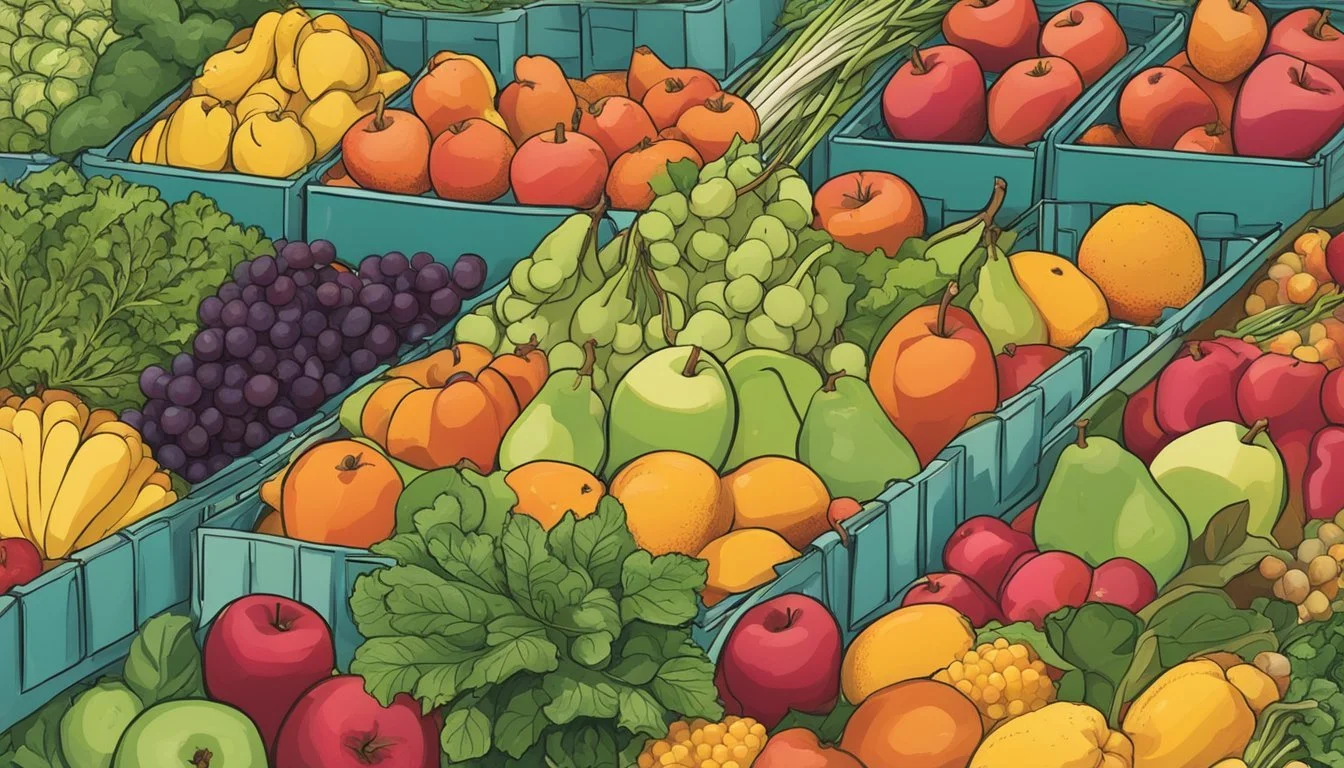Georgia Seasonal Fruit & Vegetables in November
A Guide to the Best Picks
This Article is Part of our Georgia Seasonal Fruit & Veg Calendar
In November, Georgia's rich soil and favorable climate yield a variety of seasonal produce that is ripe for the picking. This period marks the transition from the vibrant colors of autumn harvests to the more hearty and robust offerings that can withstand the cooler temperatures. Consumers looking for fresh, locally grown fruits and vegetables will find that Georgia's farms offer an array of choices that include the crisp textures and earthy flavors characteristic of late fall.
Among the produce available, November is an opportune time for Georgia residents and businesses to embrace the harvest of Brussels sprouts and carrots. These vegetables reflect the seasonal shift, providing robust flavors and nutritional benefits well-suited for the Thanksgiving table and other autumnal feasts. Additionally, collard greens (how long do collard greens last?), a Southern staple, are at their peak, offering a taste of Georgia’s culinary heritage as well as a versatile ingredient for a variety of dishes.
Shifting from green to root vegetables, Georgia's November harvest also includes sweet potatoes, one of the state's most celebrated crops. Their natural sweetness and rich textures make them a favorite for holiday recipes. While peaches, the state's iconic summer fruit, are out of season, the focus turns to these nutritious and flavorful vegetables that can be enjoyed in countless preparations from roasted side dishes to warming soups, showcasing the best of Georgia's seasonal bounty.
Overview of Georgia's Growing Seasons
Georgia's diverse climate and geography lead to distinct growing seasons throughout the year. Here, one can find a bountiful harvest that changes with the seasons, offering a variety of fresh produce.
Climate and Geography
Georgia's climate can be categorized as humid subtropical, characterized by hot summers and mild to cool winters. The state's geography ranges from the Appalachian Mountains in the north to the coastal plains in the south, both influencing the local climate and subsequently, the growing seasons. The varied terrain allows for a broad spectrum of fruits and vegetables to thrive at different times of the year.
Key Harvest Times
Spring (March to May): This is a major planting period. By late spring, early crops begin to be harvested.
Summer (June to August): Peak growing season for many of Georgia's popular crops, including peaches and blueberries.
Fall (September to November): Plantings during mid-July to September start yielding produce.
Winter (December to February): Some hearty vegetables can still be harvested in winter, depending on the region and weather conditions.
Timing for specific crops can vary based on the exact regional climates within Georgia, with northern areas being cooler and having slightly delayed harvesting times compared to the rest of the state.
Seasonal Fruits in November
In November, Georgia's seasonal fruit palette is diverse, offering a range of flavors from the zesty punch of citrus to the sweet, comforting notes of apples. This month's harvest brings a unique blend of textures and tastes to the table.
Citrus Fruits and Berries
The arrival of cooler weather marks the beginning of citrus season in Georgia, with oranges starting to hit their stride. Their vibrant, tangy flavor profiles range from sweet to tart, and they offer a refreshing contrast to the more mellow tastes of autumn's harvest. Berries are less common during this time, but some hardy varieties may still be available.
Apple Varieties
November is the time to enjoy the last of Georgia's apple harvest. A substantial selection of apple varieties is available, including those perfect for baking with their firm textures and those better suited for eating fresh due to their juicy crispness. From the tart Granny Smith to the sweet Gala, each variety offers a distinct taste experience.
Other Seasonal Fruits
Persimmons and pears are also in season during November, providing a soft, often honey-like sweetness that is a hallmark of Georgia's fall harvest. Unlike the peaches Georgia is famous for, which have a different season, these fruits shine during the autumn months with their unique flavors and textures.
Seasonal Vegetables in November
In Georgia, November marks a harvest rich in variety and flavor, particularly when it comes to root and cruciferous vegetables, as well as leafy greens and various squashes. These vegetables are known for their robust flavors and textures that blend well into hearty autumn dishes.
Root Vegetables
Root vegetables thrive in the cooler November weather, offering a combination of texture and deep flavors. Key players include:
Beets: They are versatile with an earthy sweetness, perfect for roasting or boiling.
Carrots: Known for their crispness and sweetness, carrots can be used in everything from stews to cakes.
Sweet Potatoes: With a creamy texture and rich taste, they are a staple in many Southern dishes.
Potatoes: A basic yet indispensable ingredient, offering endless culinary possibilities from mashed to roasted forms.
Cruciferous Vegetables
These vegetables are characterized by their health benefits and bold flavors, ideal for nourishing winter meals.
Cabbage: A dense vegetable that can be sautéed, fermented into sauerkraut, or used raw in salads.
Cauliflower: Often enjoyed roasted or steamed, it is a versatile vegetable that adapts to a variety of seasonings.
Leafy Greens and Squashes
November is also the time for leafy greens with rich flavors and winter squashes that offer comfort in every bite.
Kale: This hardy green is packed with nutrients, and its slightly bitter taste softens when cooked.
Collard Greens: A Southern favorite that pairs well with smoked meats, offering a hearty texture.
Squash (winter): Varieties like butternut and acorn squash provide a sweet, nutty flavor ideal for soups and side dishes.
Local Market Availability
November in Georgia brings a shift in crop availability, with markets adapting to the seasonal change. Consumers can still find a variety of fresh produce, particularly in farmers markets and grocery selections, where the tail end of autumn harvests meet winter preparations.
Farmers Markets
Farmers markets across Georgia remain a primary source for local and fresh produce during November. They offer a range of seasonal products, directly from the producers to the consumers. Shoppers looking for fresh fruits and vegetables can explore markets such as the State Farmers Market, which operates year-round. The products available in November typically include:
Fruits: Apples (from cold storage), Persimmons
Vegetables: Sweet Potatoes, Greens (e.g., Collards, Mustard Greens, Kale), Winter Squash, Pumpkins, Turnips, Rutabagas
State Farmers Markets contribute significantly to the local economy and provide a platform for farmers to sell their late-harvest crops.
Grocery Selections
Grocery stores in Georgia are well-stocked with a mix of locally sourced and imported produce, ensuring a wide selection. In November, grocery stores typically focus on stocking:
Root Vegetables: Beets, Carrots, and Radishes
Leafy Greens: Lettuces and Spinach
These seasonal items are often prominently displayed and marketed as part of Thanksgiving promotions. Grocery selections may be more diverse than farmers markets due to imports, which compensate for end-of-season local crop limitations.
Selecting and Storing Seasonal Produce
When choosing apples in November, one should look for firm and bruise-free fruit, indicative of freshness and quality. Their flavor is best preserved when stored in a cool, dark place or in the refrigerator, away from strong odors.
Potatoes, another November staple, display optimal quality through their firm texture and lack of sprouts or green spots. Store them in a cool, dark, and well-ventilated area to prevent spoilage.
Greens, such as collards and kale, are also at their peak during this month. Shoppers can identify freshness by the vibrancy of the leaves and crisp texture. To maintain freshness, greens should be stored in the refrigerator, preferably in the crisper drawer to retain moisture.
Selecting squash, consumers should choose specimens with hard, dull rinds, as a shiny exterior may indicate immaturity. Squash has a rich flavor and firm texture, making it a versatile ingredient. Store it in a cool, dark place, and it should last for several weeks.
Selection Tips Storage Apples: Firm, no bruises Refrigerate, avoid odors Potatoes: Firm, no sprouts Cool, dark, ventilated space Greens: Vibrant leaves Refrigerator crisper drawer Squash: Hard, dull rind Cool, dark place
For all produce, one should ensure cleanliness before storage, and remember that proper selection and storage are paramount to enjoying the full spectrum of flavors and textures offered by November's seasonal bounty.
Benefits of Eating Seasonally
Eating seasonally, particularly in Georgia during the fall and winter months such as November, brings a variety of benefits. Seasonal fruits and vegetables often boast a richer flavor because they are harvested at the peak of their ripeness. This not only means consumers can enjoy produce with a sweeter and more intense taste, but it also typically contains higher levels of nutrition. Fruits and vegetables like Brussels sprouts and cabbage, which are in season from fall to winter, are fresher and provide more vitamins and minerals than those that are off-season and shipped from far away.
Consumers who choose seasonal produce are indirectly supporting environmental sustainability. Local, seasonal foods consume less energy and resources in transportation and storage, leading to a smaller carbon footprint. Additionally, eating seasonally helps to reduce water and land use, pollution, and soil degradation.
Here is an overview of some seasonal produce in Georgia and their health contributions:
Brussels Sprouts (November - February): High in fiber, vitamins, and minerals that support heart and bone health.
Cabbage (October - May): Contains powerful antioxidants that contribute to improved digestion and inflammation reduction.
When individuals opt for seasonal produce, they also diversify their diet. Introducing different fruits and vegetables as they come into season may decrease the risk of certain diseases by ensuring a variety of nutrients and phytochemicals in their diet. It has been shown that variety in one's diet can be beneficial for long-term health, including reducing the risk of chronic diseases.
Georgia's Unique Produce Offerings
Georgia stands out for its rich agricultural heritage, with a climate that supports a wide range of flavorful and unique produce. Two standout offerings that define the region's agricultural identity are pecans and peanuts, as well as its famed peaches, which have earned Georgia the affectionate nickname "The Peach State."
Pecans and Peanuts
In Georgia, pecans flourish, with the state often leading the nation in production. These nutrient-rich nuts are harvested mainly in the fall, making November an ideal time for sourcing fresh Georgia pecans. Pecans are not only a versatile ingredient in the kitchen but also a symbol of Southern pride and cuisine.
Similarly, peanuts hold a place of prominence in Georgia's agricultural landscape. This legume, crucial to the state's economy, matures in its warm soil, producing a significant percentage of the nation's peanuts. Visitors and locals alike enjoy the rich taste of Georgia-grown peanuts in various forms, from boiled to roasted.
Peach State Specialties
Despite peaches not being in season during November, they are an integral part of Georgia's identity. The state's unique combination of well-drained soil and a conducive growing climate contributes to the production of high-quality peaches, which typically peak from May to August. Even when out of season, the presence of peaches can be felt across Georgia, with many products like preserves and baked goods paying homage to this beloved fruit.
Recommendations for Seasonal Cooking
In November, Georgia's harvest offers an abundance of seasonal produce that can enhance the flavors of any meal. Utilizing fresh, local ingredients not only supports local farmers but also ensures maximum flavor and nutrition.
Sweet Potatoes are a versatile root vegetable that can be transformed into a myriad of dishes. They lend themselves well to both sweet and savory applications. Try roasting them to bring out their natural sweetness, or mash them for a comforting side.
Apples are in peak season, offering varieties from tart to sweet. They can be used in classic pies or crisps, or added to savory dishes like roasted pork for a touch of sweetness.
Squash, including butternut and acorn, are ideal for roasting or creating hearty soups. Their earthy tones pair well with warming spices such as nutmeg and cinnamon, perfect for November's cooler temperatures.
Cabbage is another November gem, great for coleslaws, fermenting into sauerkraut, or sautéeing as a side. It provides a crunchy texture and a slightly peppery flavor to dishes.
Here's a quick guide to cooking with these seasonal ingredients:
Sweet Potato: Roast with rosemary, or mash with a hint of maple syrup.
Apples: Bake into pies, or add slices to a fresh salad with a vinaigrette.
Squash: Roast with a drizzle of olive oil, or puree into soup.
Cabbage: Shred into slaw, sautée with garlic, or pickle for added zest.
Incorporating these seasonal products into recipes allows a cook to create dishes that are rich in flavors and perfect for November meals in Georgia. With an array of possibilities, these ingredients can be crafted into nutritious and comforting autumnal cuisine.
Conclusion
In Georgia, the month of November is a transitional period where the remnants of autumn's bounty give way to early winter harvests. This is a time when a variety of produce reaches its peak in flavor and availability. Shoppers can find a rich selection of fruits and vegetables that are not only fresh and tasty but also supportive of local agriculture and sustainable practices.
Seasonal Vegetables:
Brussels Sprouts: Rich in flavor when harvested after the first frost.
Cabbage: Versatile in both raw and cooked dishes.
Carrots: Sweetness enhanced by the cooler temperatures.
Cauliflower: Ideal for both steaming and roasting.
Celery: Crisp and perfect for wholesome soups and stews.
Chard: Nutrient-dense greens suitable for sautéing.
Collard Greens: A Southern staple, best braised for a hearty dish.
Georgia's produce in November is a testament to the state's agricultural richness. The flavors are intense and represent the epitome of the season's offering. It's an excellent opportunity for consumers to integrate healthful and seasonal produce into their diets. To experience the full palette of November's harvest, they are encouraged to explore farmers' markets and local produce stands. This not only results in meals full of autumnal flavors but also bolsters the local economy and reduces the carbon footprint associated with long-distance food transport. It fosters a connection between Georgia's residents and the soil that nourishes their state's agriculture.









